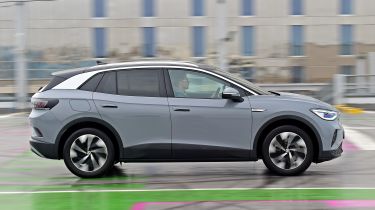Volkswagen ID.4 review: range, battery & charging
The ID.4 offers competitive electric range on paper, but real-world performance is disappointing from our experience
| Drivetrain | Battery size | Range | Wallbox charge time | Rapid charge time |
|---|---|---|---|---|
| Pure / Pure Performance | 52kWh | 223 miles | 8hrs 30mins (0-100%, 7.4kW) | 29mins (10-80%, 110kW) |
| Pro / Pro Performance | 77kWh | 317-328 miles | 12hrs 15mins (0-100%, 7.4kW) | 34mins (10-80%, 125kW) |
The ID.4 is now available with five powertrains: Pure, Pure Performance, Pro, Pro Performance (which are all rear-wheel-drive), plus Pro Performance 4MOTION and GTX, which are both available exclusively with four-wheel-drive.
Pure and Pure Performance models make use of a 52kWh battery, while Pro, Pro Performance and GTX cars make use of a larger 77kWh battery. With ID.4 Pro models offering up to 328 miles on a single charge, the Volkswagen SUV gives you electric range that’s in-line with other electric family SUVs such as the Nissan Ariya, but slightly behind that of the Tesla Model Y.
Volkswagen ID.4 range
With a maximum range of up to 223 miles from their 52kWh battery, Pure and Pure Performance cars are best-suited for those looking to spend almost all of their time driving around town. Step up to the 77kWh Pro and Pro Performance models and this figure is boosted to nearly 330 miles. During our time with the car in the mild spring weather, we could only achieve a range of 235 miles, which is a far cry from VW’s claimed figure. We recommend specifying the optional heat pump (around £1,000) to maximise efficiency during the winter months.
The high-spec GTX models come with the 77kWh battery, too, although range is lower than for other versions, at 308 miles between charges. This can be attributed to the all-wheel-drive powertrain, higher power output and added weight of the GTX’s additional standard equipment.
Charge time
You can top the ID.4 up quickly thanks to 110 or 125kW rapid charging capability, with the difference in battery size all but cancelling out the difference in total charging times across the various models. If you buy a model capable of charging at 135kW and can find a fast enough charger 'in the wild', you can add nearly 200 miles of range in just 30 minutes. Using a home wallbox charger, you can take the 77kWh battery from empty to full in 12 hours and 15 minutes, which is doable overnight. The 52kWh versions take eight-and-a-half hours to do the same.




